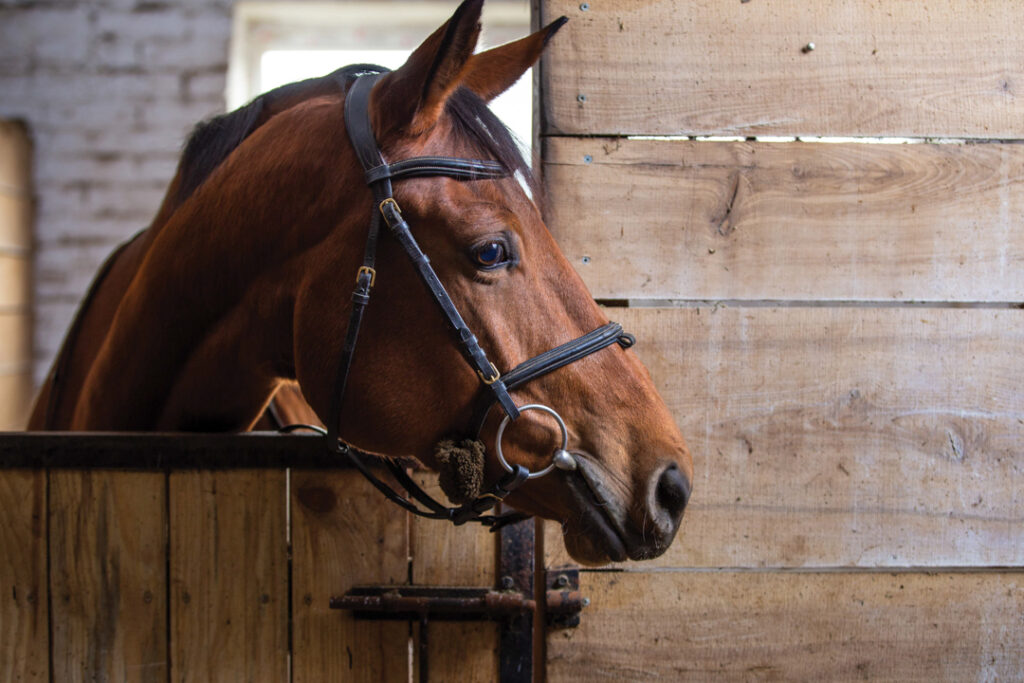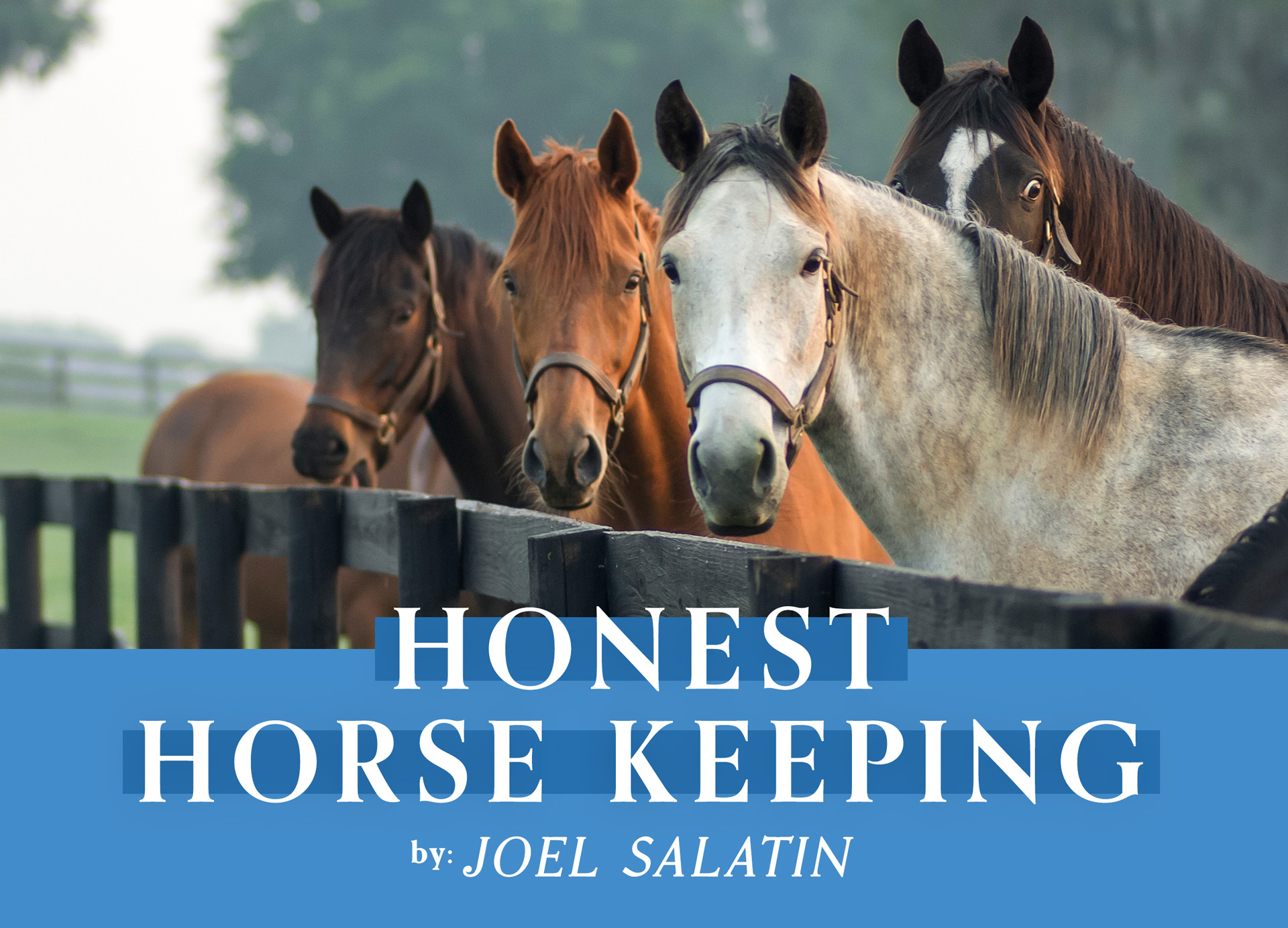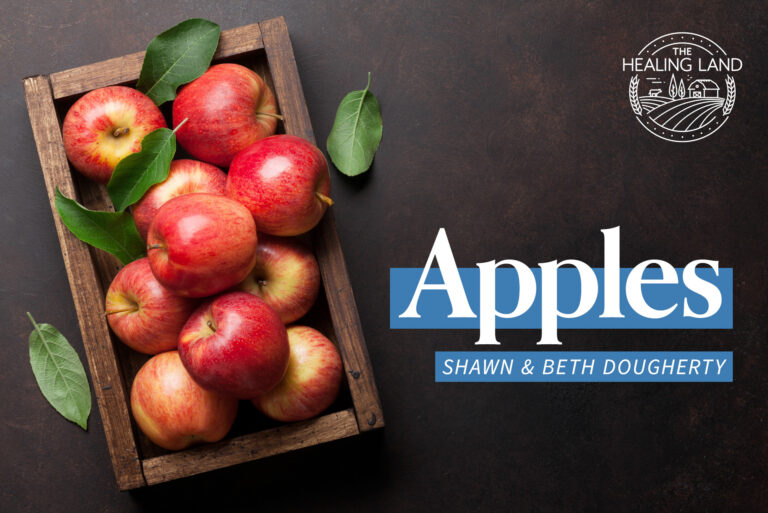by Joel Salatin, Plain Values
I don’t own a horse. I don’t keep a horse. That’s precisely why I’m qualified to address the issue—I don’t have preconceived notions about keeping horses. I have thought and yakked about it quite a bit, though, because one of the most common questions people ask me is about keeping a horse.
Whether for recreation or work, in my experience, some of the worst ecological abuse is in horse lots. Many of my friends keep horses, and I’ve been to many places that keep horses, from full-time equestrian outfits to the honeymoon-is-over-seldom-ridden situations.
More than 30 years ago, Equine News, a leading equestrian magazine, carried a front-page article about deep bedding and horses. In my short history with Plain Values, readers are already familiar with my basic pitch that the only honest way to house animals is on deep bedding. I mean deeper than 12 inches and preferably 24 inches or more.
Furthermore, I’ve already introduced readers to the necessity of animal movement. Not only is that foundational to hygiene and sanitation, but it’s also the only way to keep the ground vegetated with lush, healthy forage. The problem is that almost no one adheres to either of these principles—deep bedding inside; rest and rotation outside—in horse keeping.
Stables use a skiff of sawdust, shavings, or other carbonaceous material in the stalls and use a special fork to clean out the road apples every day. Mucking stalls is the number one labor requirement in conventional stable operations. The bedding is never more than a couple of inches deep, often covering some sort of expensive cushiony mat to keep things softer for the hooves.
Whatever outdoor access the horses have is a denuded lot with a few hardy thistles or other unpalatable weeds. The hard soil does not absorb rain; over time, the paddock resembles a moonscape more than a verdant prairie.
The single biggest problem with horses, compared with all the other livestock species, is that they are harder to crowd into tight outdoor spaces. With an electric fence, you can put 400 cows on an acre for a day, and they’ll be content—I know because I’ve done it. But 400 horses on an acre for a day would not be content. They’d be agitated and hard to keep in with the electric fence. Even 50 would be hard to do.
Remember that nature sanitizes only two ways: rest and sunshine or vibrant decomposition. Please see earlier articles to get the background on this if you need to refresh your memory. In a lightly bedded stable and a denuded exercise yard, neither of these sanitation principles happens. Thin bedding doesn’t offer enough depth to support decomposing microbes, and the outside paddock doesn’t get rested. In fact, it gets pounded every day.
This is a real dilemma for the horse keeper. What can we do to rectify this debilitating situation? The study cited in that old Equine News article focused primarily on hoof health. Next to mucking out stalls, the next biggest horse expense is farrier expense. With deep bedding, according to the study, hooves respond to the microbial and fungal exudates and stay healthier. For hoof health and reduced farrier costs, therefore, deep bedding is the best approach.

But whose stable is built to handle bedding 24 inches deep, let alone 36 or 48 inches? This idea requires a complete re-think of the conventional stable/stall design. Yes, it requires retaining boards, a retaining sill at the gate entrance, and tall enough sidewalls to accommodate a horse standing 24 inches above ground level. Lest anyone thinks this idea requires far more carbonaceous bedding material, it actually doesn’t. Rather than mucking out stalls every day, the absorptive carbon composts as the urine and manure fall on it, creating vibrant decomposition with its incumbent health benefits.
Yes, the initial 12-inch bedding blanket will be a lot of carbon at once, but as the pack builds, the decomposition reduces its mass, just like in a compost pile. The actual take-out material is half what was initially put in, and that procedure only needs to happen once a year. Forget the daily clean out. Abolishing the daily mucking makes the one-day clean out seem like a picnic.
Now how about outside? Horses do respect electric fences quite well, which means they are compatible with cows on a single strand or sheep with electric netting. I don’t know how much room a horse needs to feel comfortable, but from what I’ve seen, a quarter acre is probably acceptable. As long as the horse is trained not to chase the cows or the sheep, it could live in the flock or herd and move along with them. That way keeping a horse doesn’t require any additional infrastructure. And no additional time.
The problem is when no compatible flock or herd offers a complementary and compatible keeping alternative. With just a horse or two, the outside paddock is a real problem. The fact is no place on earth grows vegetation fast enough for a one-acre paddock to adequately house a horse and be divided into enough paddocks to offer vegetation and pathogenic relief with long enough rest periods. It’s just not ecologically possible.
So what’s a horse keeper to do? Normally horse keepers use their horses for riding or towing things. Horses normally aren’t just wall candy. That means the horse should routinely receive necessary exercise and an outdoor exercise paddock is not necessary. Generally, the outdoor paddock is simply part of the keeping model; it’s there because that’s what horse people do. It’s no more necessary than roosts for chickens or heated doghouses for Fido.
It’s just accepted practice, and nobody questions it. I’m questioning it unless and until someone figures out how to have one without it being an ecological and pathogenic disaster. The alternative is roomier housing. Many stable builders spend more than $10,000 per stall due to peer dependency. A stall doesn’t need tongue-and-grooved walls. In fact, a stall could be a roomy pole structure with some cheap uncut pole timber (straight, small-diameter trees) around the outside to control the horses.
No horse cares if its stall costs $10,000 or $1,000 as long as it offers shelter, a clean, enjoyable lounge area, and enough space to move around. If you get rid of the expensive cushiony floors, go to deep bedding for the softness, and get rid of the tongue-and-grooved solid walls, the horse can enjoy commodious accommodations for pennies.

Many horse businesses create the worst of all worlds with run-in sheds placed strategically in their outdoor paddocks. Unfortunately, the run-ins don’t have deep bedding, and the horses eat the paddocks into the ground. In these situations, the horses don’t win; the ecology doesn’t win; the owners don’t win. The ones who win are the farriers and the veterinarians.
Cheap pole structures can offer expansive housing at extremely low cost. When combined with deep bedding, this housing reduces vet bills, farrier care, and daily mucking labor. That’s a win for the horse keeper. A covered loafing shed for horses certainly doesn’t need weather-tight walls. At our farm, we don’t even have sides on our barns. An open-sided shed is actually healthier for the animals because it’s almost like being outside but under protection. That offers the best of all worlds.
Finally, I’ll offer one more twist. If I were in the stable business, I would use deep bedding in the stalls and keep one empty each day, advancing the horses each day to another stall and vacating one. Two pigs would live in the vacated stall, of course also advancing one stall a day. The pigs would stir the bedding, adding oxygen, picking out bits of feed and fermented waste, all stimulating vibrant decomposition.
Clients would soon enjoy and befriend the two working pigs (pig-aerators) as much as the horses. I submit that such a stable business would attract new clients due to the novelty of the patrons also being able to enjoy pigs. Where do you get that diversity at a conventional stable outfit? For the one-day-a-year clean-out, I’d get all my clients to come with forks and wheelbarrows and have a pork barbecue, turning a daily chore into an annual celebratory shared-work day and shindig. This would put an exclamation point on a differentiated, unique horse boarding experience.
At this point, I can imagine lots of raised eyebrows and legitimate questioning of my credentials to discuss horses. But with our farm, I’ve found that over the years, my biggest breakthroughs have often been found in advice from strangers. Perhaps one day I’ll mention several of them, but they are profound. The problem is that when we’re in the midst of our situation, it’s hard to imagine a different situation. But when someone waltzes into our context without all the baggage, the assumptions, the “we’ve always done it this way” encumbrances, they can bring a fresh perspective we wouldn’t ever consider.
To this day, I solicit advice from visitors. I’m just reporting how I would adapt our livestock handling and housing for the many horse-keeping folks I’ve visited. I’ve seen those denuded paddocks. I’ve heard the complaints about mucking. And farrier bills. Why not try something out of the box for a change? //
This article was published in the August 2022 issue of Plain Values Magazine. If you want the latest stories every month, subscribe to the magazine HERE. As a special thanks, get 10% off your subscription with the code “GAB23”!

Joel Salatin co-owns, with his family, Polyface Farm in Swoope, Virginia. Four generations of his family currently live and work on the farm, and his farm services more than 5,000 families, 50 restaurants, 10 retail outlets, and a farmers’ market with salad bar beef, pigaerator pork, pastured poultry, and forestry products. When he’s not on the road speaking, he’s at home on the farm, keeping the callouses on his hands and dirt under his fingernails, mentoring young people, inspiring visitors, and promoting local, regenerative food and farming systems. Salatin has published 15 books, and he is the editor of The Stockman Grass Farmer, granddaddy catalyst for the grass farming movement. He passionately defends small farms, local food systems, and the right to opt out of the conventional food paradigm.





